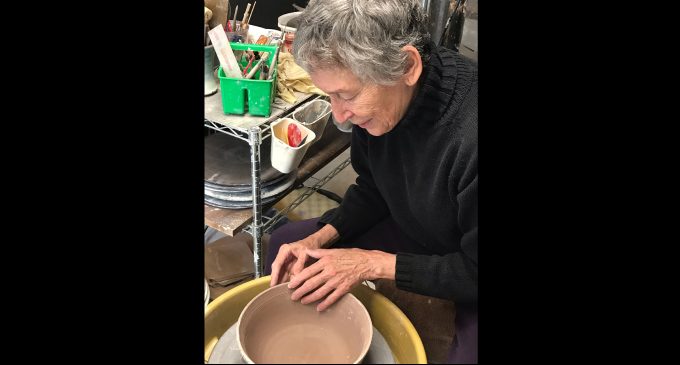Learn how to throw a pot … it just takes 25 years to do it right
Christine works to create a pottery piece.

By Christine Marshall
It all started with this odd corner in our living room that desperately needed a camouflage to hide an awkward furniture arrangement.
A big clay pot, some dried twigs, that’s just the thing, I thought. We had just moved to North Carolina and everyone talked about the “Clay Mecca” pottery heaven: Seagrove – about 30 miles down the road.
So off my friend and I went one weekend, like great hunters, stalking the perfect pot. We found everything from the fabulous to the trite, and we had barely scratched the surface. We repeated the search Saturday after Saturday; we met some of the legendary Seagrove potters, but the large pot I had envisioned proved to be elusive.
Then one day, somebody pointed us in the direction of Pittsboro. Nestled into the woods, down a little caliche road, we found Mark Hewitt’s studio. He was throwing pots at his wheel in the mellow fall light as he talked about his family, three generations of pottery history in England, and how he made this area his home, based on its wonderful clay. Lined up all around him were shelves of pottery waiting to be fired, the kind of pots I had envisioned. I ordered one right on the spot!
With business concluded, we continued to watch him work. It was a hypnotic process: a gob of clay patted onto the wheel and almost magically, a pot rose up, practically by itself. Every piece was as perfect as the last. It looked so easy – I was hooked.
Everyone who has ever started out to do something that appears “easy” knows where this story is going.
I immediately signed up for a pottery class in Winston-Salem. I will let you in on a secret: the clay does not do what your brain wills it to do. You grow a minimum of sixteen additional fingers, most of them thumbs, and they all get in the way of the clay. The journey I innocently embarked on led me down the road of hard work, stubborn persistence, and endless frustration.
Your mind sees something artistic, an organically shaped vase, simple and elegant, but what invariably takes shape has the aesthetics of a child’s summer camp project. I plugged along. A lot of my practice sessions seemed to put me even more at odds with the wheel.
My friends graciously accepted presents of lumpy bumpy things “It’s the thought that counts!” No lid ever fit the vessel it graced; nothing ever rose easily from my bumbling fingers. If someone asked “What are you making?” the only honest answer was “a mess.”
Twenty-five years and some months later, I see a ray of hope. I may yet be on the way to becoming a real potter, though no one will mistake me for a professional any time soon. I would starve to death if I ever tried.
But sometimes when I am bent over the wheel and everything goes just right, I feel a whisper of the ancient art in my fingertips. The clay glides softly through my hands, the shape is pleasing, and the satisfaction is huge. I feel a wonderful sense of connection to the delicate porcelains of China and the fabulous pieces of ancient Greece and Rome, not to speak of my forbearers, who made salt-fired pots for everyday use.
I make an effort to support and mentor struggling beginners. They touch my heart, remembering how I have struggled mightily to conquer the spinning ball of clay.
An an effort to give back to my community, I have donated about 50 bowls I made for Empty Bowls that supports the mission of the Second Harvest Food Bank, which will be held April 21 and 22. I hope you will go and select one of my bowls and that it will inspire you to learn something new. Hopefully, it won’t take you 25 years.
Christine Marshall was born in Germany, came to the USA in 1963, and moved to Winston-Salem in 1991. She has been married for 54 years. Christine spent most of career in marketing and sales. She started pottery classes at Sawtooth in 1994. An adventurous cook and enthusiastic bread baker, Christine’s hobbies are pottery and horseback riding.










